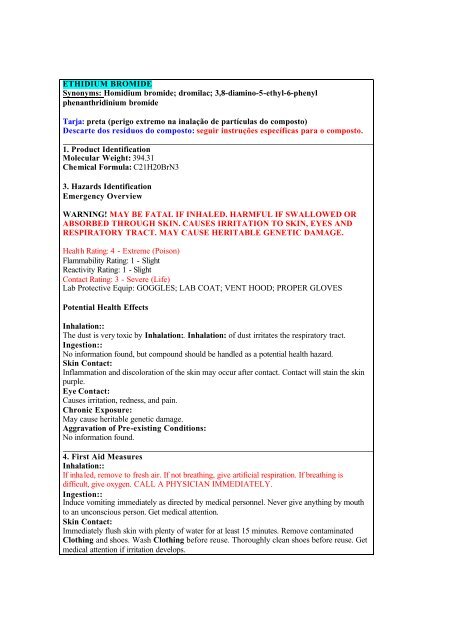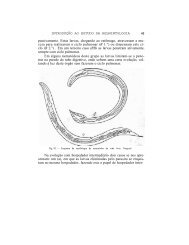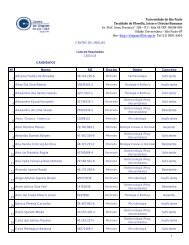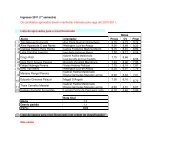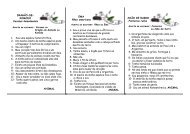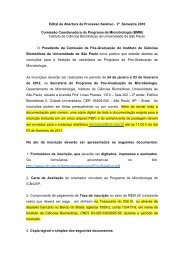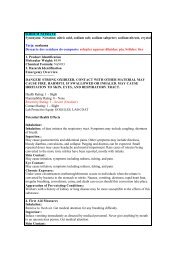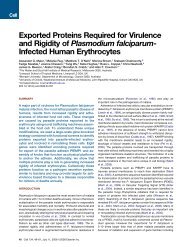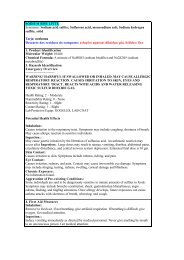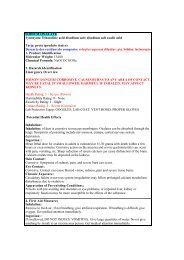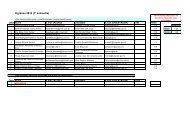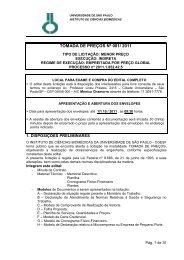ETHIDIUM BROMIDE Synonyms: Homidium bromide ... - USP
ETHIDIUM BROMIDE Synonyms: Homidium bromide ... - USP
ETHIDIUM BROMIDE Synonyms: Homidium bromide ... - USP
You also want an ePaper? Increase the reach of your titles
YUMPU automatically turns print PDFs into web optimized ePapers that Google loves.
<strong>ETHIDIUM</strong> <strong>BROMIDE</strong><strong>Synonyms</strong>: <strong>Homidium</strong> <strong>bromide</strong>; dromilac; 3,8-diamino-5-ethyl-6-phenylphenanthridinium <strong>bromide</strong>Tarja: preta (perigo extremo na inalação de partículas do composto)Descarte dos resíduos do composto: seguir instruções específicas para o composto.1. Product IdentificationMolecular Weight: 394.31Chemical Formula: C21H20BrN33. Hazards IdentificationEmergency OverviewWARNING! MAY BE FATAL IF INHALED. HARMFUL IF SWALLOWED ORABSORBED THROUGH SKIN. CAUSES IRRITATION TO SKIN, EYES ANDRESPIRATORY TRACT. MAY CAUSE HERITABLE GENETIC DAMAGE.Health Rating: 4 - Extreme (Poison)Flammability Rating: 1 - SlightReactivity Rating: 1 - SlightContact Rating: 3 - Severe (Life)Lab Protective Equip: GOGGLES; LAB COAT; VENT HOOD; PROPER GLOVESPotential Health EffectsInhalation::The dust is very toxic by Inhalation:. Inhalation: of dust irritates the respiratory tract.Ingestion::No information found, but compound should be handled as a potential health hazard.Skin Contact:Inflammation and discoloration of the skin may occur after contact. Contact will stain the skinpurple.Eye Contact:Causes irritation, redness, and pain.Chronic Exposure:May cause heritable genetic damage.Aggravation of Pre-existing Conditions:No information found.4. First Aid MeasuresInhalation::If inhaled, remove to fresh air. If not breathing, give artificial respiration. If breathing isdifficult, give oxygen. CALL A PHYSICIAN IMMEDIATELY.Ingestion::Induce vomiting immediately as directed by medical personnel. Never give anything by mouthto an unconscious person. Get medical attention.Skin Contact:Immediately flush skin with plenty of water for at least 15 minutes. Remove contaminatedClothing and shoes. Wash Clothing before reuse. Thoroughly clean shoes before reuse. Getmedical attention if irritation develops.
Eye Contact:Immediately flush eyes with plenty of water for at least 15 minutes, lifting upper and lowereyelids occasionally. Get medical attention if irritation persists.5. Fire Fighting MeasuresFire:As with most organic solids, fire is possible at elevated temperatures or by contact with anignition source.Explosion:Not an explosion hazard under normal conditions of Storage and use, but fine dust dispersedin air in sufficient concentrations, and in the presence of an ignition source is a potential dustexplosion hazard. Sensitive to static discharge.Fire Extinguishing Media:Water spray, dry chemical, alcohol foam, or carbon dioxide.Special Information:In the event of a fire, wear full protective Clothing and NIOSH-approved self-containedbreathing apparatus with full facepiece operated in the pressure demand or other positivepressure mode.6. Accidental Release MeasuresRemove all sources of ignition. Ventilate area of leak or spill. Wear appropriate personalprotective equipment as specified in Section 8. Spills: Clean up spills in a manner that does notdisperse dust into the air. Use non-sparking tools and equipment. Reduce airborne dust andprevent scattering by moistening with water. Pick up spill for recovery or disposal and place ina closed container.7. Handling: and StorageAvoid dust formation and control ignition sources. Employ grounding, venting and explosionrelief provisions in accord with accepted engineering practices in any process capable ofgenerating dust and/or static electricity. Empty only into inert or non-flammable atmosphere.Emptying contents into a non-inert atmosphere where flammable vapors may be present couldcause a flash fire or explosion due to electrostatic discharge. Contact will stain the skin purple.Wash gloves before removing them from the hands. Containers of this material may behazardous when empty since they retain product residues (dust, solids); observe all warningsand precautions listed for the product.8. Exposure Controls/Personal ProtectionAirborne Exposure Limits:None established.Ventilation System:A system of local and/or general exhaust is recommended to keep employee exposures as lowas possible. Local exhaust ventilation is generally preferred because it can control theemissions of the contaminant at its source, preventing dispersion of it into the general workarea. Please refer to the ACGIH document, Industrial Ventilation, A Manual of RecommendedPractices, most recent edition, for details.Personal Respirators (NIOSH Approved):For conditions of use where exposure to dust or mist is apparent and engineering controls arenot feasible, a particulate respirator (NIOSH type N95 or better filters) may be worn. If oilparticles (e.g. lubricants, cutting fluids, glycerine, etc.) are present, use a NIOSH type R or Pfilter. For emergencies or instances where the exposure levels are not known, use a full-facepositive-pressure, air-supplied respirator. WARNING: Air-purifying Respirators do not
protect workers in oxygen-deficient atmospheres.Skin Protection:Wear protective gloves and clean body-covering Clothing.Eye Protection:Use chemical safety goggles. Maintain eye wash fountain and quick-drench facilities in workarea.9. Physical and Chemical PropertiesAppearance: Dark red crystals.Odor: Faint characteristic odor.Solubility: 5 grams in 100 grams of water.pH: 4 - 7 (2% solution)Melting Point: 238 - 240C (460 - 464F)10. Stability and ReactivityStability:Stable under ordinary conditions of use and Storage.Hazardous Decomposition Products:Toxic gases and vapors may be released if involved in a fire. Oxides of nitrogen, oxides ofcarbon, hydrogen <strong>bromide</strong>.Hazardous Polymerization:Will not occur.Incompatibilities:Strong oxidizers.Conditions to Avoid:Heat, flames, ignition sources and incompatibles.11. Toxicological InformationEthidium <strong>bromide</strong>: Oral rat LD50: 1503 mg/kg (males); Inhalation: rat LC50: 0.118 to 0.134mg/liter. Ethidium <strong>bromide</strong> is genotoxic in a number of test systems, including Ames, cellmutation, cell transformation and cytogenetics assays.


